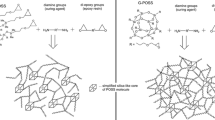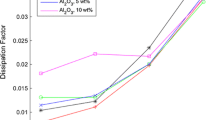Abstract
The presence of metal ions as impurities during the production and use of epoxy resin insulating materials can significantly affect the breakdown strengths and dielectric properties of epoxy resins. In this study, five epoxy resins with different alkali metal ions contents were prepared and their physicochemical parameters, such as glass transition temperature (Tg) and industrial frequency breakdown voltage, were examined. Increasing alkali metal ion mass fraction promoted the formation of a cross-linked epoxy resin network, with subsequent inhibition. Consequently, Tg and the cross-linking density of the epoxy resin increased at first and decreased subsequently. By contrast, the industrial frequency breakdown voltage decreased continuously with the increasing Na+ mass fraction. When the Na+ content was increased to 0.04 wt.%, Tg increased by 8°C, the cross-linking density increased by 32.6%, and the industrial frequency breakdown voltage decreased by 33.5%. The effects of Na+ content on the cross-linking reactions of the epoxy resin were further evaluated by studying the promotion and inhibition of these reactions using density functional theory. At a low Na+ content (<0.04 wt.%), Na+ bonded to the curing agent and resin molecule. Additionally, Na+ promoted the ring opening of the anhydride and epoxy resin molecule; however, at a higher Na+ content (>0.04 wt.%), Na+ combined with the epoxy groups in the epoxy resin molecules, forming O–Na bonds and thus inhibited the construction of the cross-linked network.










Similar content being viewed by others
References
Y. Chen, Z. Li, Y. Liu, C. Teng, and W. Cui, Curing mechanism and mechanical properties of Al2O3/cyanate ester–epoxy composites. J. Electron. Mater. 49, 1473 (2020).
Z. Pan, S. Zhu, B. Huang, Y. Kang, and L. Zhu, Synthesis of high-refractive-index epoxy-modified vinyl methyl phenyl silicone resins for encapsulation of LEDs. J. Electron. Mater. 48, 2865 (2019).
W. Rmili, M. Deffarges, F. Chalon, Z. Ma, and R. Leroy, Dynamic mechanical properties and thermal effect of an epoxy resin composite, encapsulation’s element of a new electronic component. J. Electron. Mater. 43, 702 (2014).
T. Giang, and J. Kim, Effect of liquid-crystalline epoxy backbone structure on thermal conductivity of epoxy–alumina composites. J. Electron. Mater. 46, 627 (2017).
Y. Cao, Y.F. Shao, J. Sun, and S.A. Lin, Mechanical properties of an epoxy resin toughened by polyester. J. Appl. Polym. Sci. 90, 3384 (2003).
X. Yin, Z. Xie, Q. Liu, X.B. Yuan, X. Hou, and J. Zhao, Synergistic toughening of epoxy resin by CTBN and CM-β-CD. J. Appl. Polym. Sci. 138, 51248 (2021).
X.X. Shi, X.K. Lin, C.H. Xu, and M.Z. Cui, Dynamics and thermal properties of epoxy resin cured by new diamino disiloxanes. J. Appl. Polym. Sci. 132, 42385 (2015).
D.H. Kim, A. Yu, and M. Goh, Oxidative chemical depolymerization of thermoset epoxy resin for green recycling. J. Ind. Eng. Chem. 96, 76 (2021).
C. Higuchi, D. Horvath, G. Marcou, K. Yoshizawa, and A. Varnek, Prediction of the glass-transition temperatures of linear homo/heteropolymers and cross-linked epoxy resins. ACS Appl. Polym. Mater. 6, 1430 (2019).
H. Maka, T. Spychaj, and R. Pilawka, Epoxy resin/ionic liquid systems: the influence of imidazolium cation size and anion type on reactivity and thermomechanical properties. Ind. Eng. Chem. Res. 14, 5197 (2012).
Y. Celikbag, S. Meadows, M. Barde, S. Adhikari, G.B. Diller, M.L. Auad, and B.K. Via, Synthesis and characterization of bio-oil-based self-curing epoxy resin. Ind. Eng. Chem. Res. 56, 9389 (2017).
S.S. Vinay and C.V. Venkatesh, Effect of nano-Al2O3 particles on mechanical and wear behaviour of glass fibre epoxy composites. Mater. Today: Proc. 46, 9004 (2021).
M. Ozen, G. Demircan, M. Kisa, A. Acikgoz, G. Ceyhan, and Y. Lsiker, Thermal properties of surface-modified nano-Al2O3/kevlar fiber/epoxy composites. Mater. Chem. Phys. 278, 125689 (2021).
W.A.L. Sanchez, C.Y. Huang, J.X. Chen, Y.C. Soong, Y.N. Chan, K.C. Chiou, T.M. Lee, C.C. Cheng, and C.W. Chiu, Enhanced thermal conductivity of epoxy composites filled with Al2O3/boron nitride hybrids for underfill encapsulation materials. Polymers 1, 147 (2021).
F. Lin, Y.Y. Liu, and M. Fei, Effect of ionic impurities on the properties of epoxy resin after curing and curing. Insul. Mater. 3, 8 (1981).
E.D. Nascimento, A. Ramos, D. Windmoller, P.R. Rodrigo, R.T. Juanes, A.R. Greus, V.A. Borras, L.A.F. Coelho, Breakdown, free-volume and dielectric behavior of the nanodielectric coatings based on epoxy/metal oxides. J. Mater. Sci.: Mater. Electron. 27, 9240 (2016).
F. Aslam, Z. Li, G. Qu, Y. Feng, S.J. Li, S.T. Li, and H.Y. Mao, Improvement of DC breakdown strength of the Epoxy/POSS nanocomposite by tailoring interfacial electron trap characteristics. Materials. 14, 1298 (2021).
R. Hagen, L. Salman, B. Stenberg, Effects of the type of crosslink on viscoelastic properties of natural rubber. J. Polym. Sci., Part B: Polym. Phys. 34, 1997 (1996).
B. Saville and A.A. Watson, Structural characterization of sulfur-vulcanized rubber networks. Rubber Chem. Technol. 40, 100 (1967).
G.B. Tang, H.B. Deng, X.B. Hao. Preparation method of bisphenol A liquid epoxy resin. CN102816137 A. 2012.
J. Pielichowski and P. Czub, Synthesis of low-molecular-weight epoxy resins under phase transfer catalysis (PTC) conditions. Polimery. 42, 96 (1997).
P. Krol, B. Krol, and E. Dziwinski, Influence of the synthesis conditions on the properties of low-molecular weight epoxy resin. Polimery. 48, 549 (2003).
K.R. Yang, W.J. Chen, Y.S. Zhao, Y. He, X. Chen, B. Du, W. Yang, S. Zhang, and Y.F. Fu, Enhancing dielectric strength of epoxy polymers by constructing interface charge traps. ACS Appl. Mater. Interfaces. 22, 25850 (2021).
W.W. Wang, D.M. Min, and S.T. Li, Understanding the conduction and breakdown properties of polyethylene nanodielectrics: effect of deep traps. IEEE Trans. Dielectr. Electr. Insul. 23, 564 (2016).
S. Silvarajoo, U.M. Osman, K.H. Kamarudin, M.H. Razali, H.M. Yusoff, I.U.H. Bhat, M.Z.H. Rozaini, and Y. Juahir, Dataset of theoretical molecular electrostatic potential (MEP), highest occupied molecular orbital-lowest unoccupied molecular orbital (HOMO-LUMO) band gap and experimental cole-cole plot of 4-(ortho-, meta- and para-fluorophenyl)thiosemicarbazide isomers. Data Brief. 32, 106299 (2020).
M. Meunier and N. Quirke, Molecular modeling of electron trapping in polymer insulators. J. Chem. Phys. 113, 369 (2000).
Acknowledgments
This work was supported by the Science and Technology Project of the SGCC (5500-202158245A-0-0-00).
Author information
Authors and Affiliations
Corresponding author
Ethics declarations
Conflict of interest
The authors have no conflict of interest to declare.
Additional information
Publisher's Note
Springer Nature remains neutral with regard to jurisdictional claims in published maps and institutional affiliations.
Rights and permissions
About this article
Cite this article
Liu, Q., Du, B., Mai, Y. et al. Study of the Effects of Doping Alkali Metal Ions on Cross-Linked Network of Epoxy Resins and Analysis of Insulation Properties. J. Electron. Mater. 51, 3141–3149 (2022). https://doi.org/10.1007/s11664-022-09571-1
Received:
Accepted:
Published:
Issue Date:
DOI: https://doi.org/10.1007/s11664-022-09571-1




